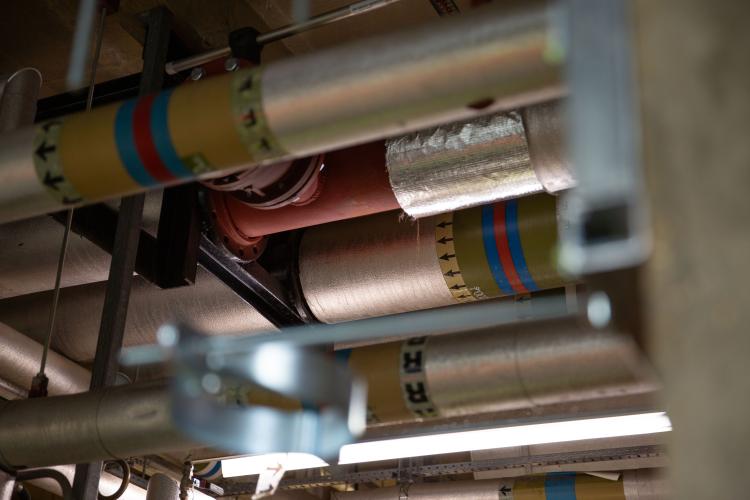How spinal patients are benefiting from energy efficiency works

The Public Sector Decarbonisation Scheme Phase 3b funding has been a game-changer for our Trust. It represents a substantial investment in our estates energy infrastructure – the largest in recent memory – and a major leap forward in our decarbonisation journey.
Salix visits Salisbury NHS Foundation Trust’s £10.3m decarbonisation project
Spinal patients are already benefiting from warmer wards, thanks to major energy efficiency works at Salisbury NHS Foundation Trust.
And the better environment is helping recovery rates, say carers.
During a visit to Salisbury our Salix team found out more about the extensive works at the hospital and how patients’ lives are being impacted.
The NHS Foundation Trust, which has plans to introduce 13 low carbon heat pumps to their District Hospital, has received funding from the Public Sector Decarbonisation Scheme
During the day our team toured the Recreation Hall in the Duke of Cornwall Spinal Treatment Centre where we had the chance to hear about the impact of the insulation upgrades.
Patients can spend three to six months in the centre.
“The upgrades have been a massive gift. This room felt dark and dingy before but now the patients enjoy being in here more. It is a key social space and an area where the patients spend a lot of time. It now feels lighter, brighter, and warmer.
“Patients struggle to control their own temperatures and previously this would be a topic of conversation or complaint when providing feedback to staff. Since the windows have been upgraded this hasn’t been brought up once.”

Photo credit: Inez Szczepanska
Delivering on care and decarbonisation
Salisbury NHS Foundation Trust’s District Hospital has been providing quality care for more than 81 years, with a rich history that includes the treatment of wounded soldiers from the D-Day landings to the invention of the first kidney dialysis machine.
Today, 5,561 staff members deliver a range of clinical care to around 270,000 people in Wiltshire, Dorset, and Hampshire.
Specialist services, extend to a much wider population of more than three million people.
Developed in 2021, the hospital’s Green Plan maps out it’s carbon reduction objectives which support the NHS’s goal to deliver a carbon net zero healthcare system, by 2040.
Top priorities include embedding sustainability into its culture and processes, introducing low carbon energy sources and engaging with the wider community to create more energy efficient methods of working.
As well as visiting the spinal unit, we also took a look at the low carbon technologies introduced to the Breast and Gynaecology building, Main Energy Centre, North Energy Centre and Odstock Health and Fitness Centre.
There was a clear sense of enthusiasm for the impact of the low carbon alternatives which will help the hospital reach the goals mapped out in the Green Plan.
Sustainability Manager at Salisbury NHS Foundation Trust, Gemma Heath, said “This project is a huge step forward in our net zero strategy and it’s an incredibly exciting process to be a part of.
“We look forward to seeing the upgrades take shape and to witness the positive impact that they will have on the environment for staff and visitors.”
Air and water heat pumps will be installed to the three plant rooms at the Main Energy Centre, Duke of Cornwall Spinal Treatment Centre and Odstock Health and Fitness Centre.
Heat pumps are a low-emission alternative to traditional, gas-based heating systems given the way in which they generate warmth through heat transfer, rather than combustion.
During the day our team had a chance to look at the roof of the Breast and Gynaecology building which boasts more than 125 solar PV panels. It is one of the nine smaller buildings with solar PV across the hospital.
The North Block is one of these buildings and has an impressive 1,100 panels on its roof. The panels are 20% more efficient than the previous technologies, producing more electricity despite being the same size.
We also visited the Main Energy Centre. Energy and Carbon Analyst from Salix Sophia Herman was particularly inspired by the NHS Trust’s vision.
Sophia from Salix said: “It is incredible to see how these plans are taking shape and to understand the vision behind them.
“When we visit sites like this, we gain a greater understanding of the challenges organisations face but also the real passion behind the work.”
The Trust plans to introduce three water to water and three air to water heat pumps to the building.
To prepare the current infrastructure for the heat pumps, the construction team had the difficult task of upgrading the pipes while they were still in use by using a process called ‘hot tapping.’
And because they could not turn the heating off, the engineering team had to drill while the pipes were still sealed to prepare the structure for the heat pumps.
The heat pumps take the load from the building’s combined heat and power unit (CHP). The Trust are working to reduce its impact by recovering the wasted heat that it releases and converting it into energy that can be used on site.
For Salix, our visit came to an end at the Odstock Health and Fitness Centre, where three heat pumps will be introduced to heat both the main and learner pools as well as the rest of the building.

Photo credit: Inez Szczepanska
Geothermal technology
The Trust is also investigating the potential of geothermal technology, with initial stages showing promising signs for its potential application according to Interim Deputy Head of Estates, Thomas Sneddon.
Thomas said: “Although implementation could take them up to a decade. This technology presents a highly sustainable and long-term solution for delivering thermal energy to the Trust, providing the benefit of their own on-site renewable energy source.
“The Public Sector Decarbonisation Scheme Phase 3b funding has been a game-changer for our Trust. It represents a substantial investment in our estates energy infrastructure – the largest in recent memory – and a major leap forward in our decarbonisation journey.
“This project serves as a powerful testament to the necessity of Government funding for public sector organisations like ours. It demonstrates the transformative potential of such investments in accelerating our journey toward a more sustainable future.”
Programme Manager at Salix, Aerk Dimri, said: “It was great getting to know the team working on this impressive project using various heat pump technologies to heat upgraded, well-insulated buildings.
“Their dedication ensures the hospital runs seamlessly, prioritising the comfort of patients, staff, and visitors.
“This initiative not only enhances the immediate environment but also aligns with the broader goal of reducing the facility's carbon footprint, contributing significantly to the decarbonisation of the UK's public sector estates.”
At Salix we are excited to continue to work with the passionate members of the Trust and to hear and see more about the positive impacts the project is making to its community.



